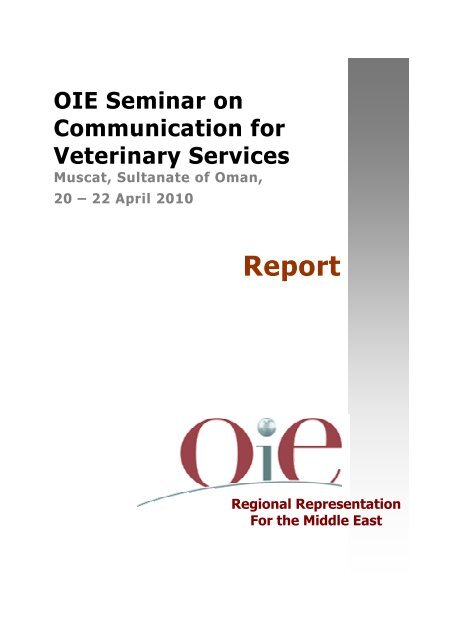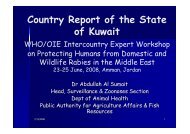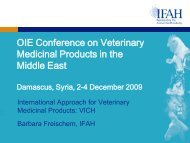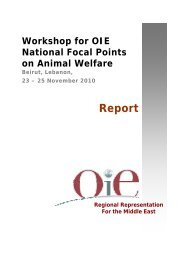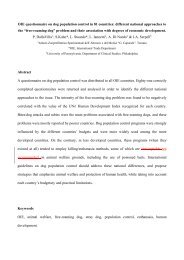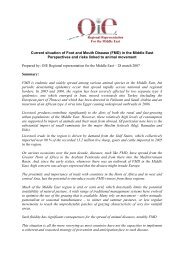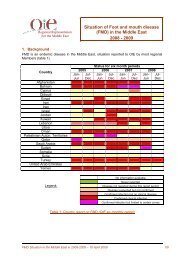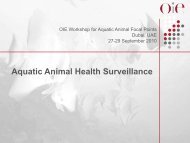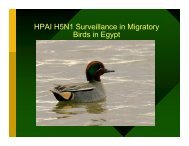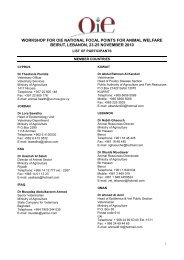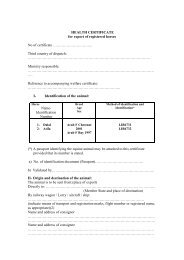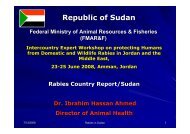Report - Middle East - OIE
Report - Middle East - OIE
Report - Middle East - OIE
You also want an ePaper? Increase the reach of your titles
YUMPU automatically turns print PDFs into web optimized ePapers that Google loves.
<strong>OIE</strong> Seminar on<br />
Communication for<br />
Veterinary Services<br />
Muscat, Sultanate of Oman,<br />
20 – 22 April 2010<br />
<strong>Report</strong><br />
Regional Representation<br />
For the <strong>Middle</strong> <strong>East</strong>
Table of contents<br />
Acronyms ......................................................................................................................3<br />
Proceedings of the Workshop ..........................................................................................4<br />
The Inauguration Ceremony............................................................................................5<br />
Session – 1 Critical Thinking............................................................................................6<br />
The importance of communication for Veterinary Services worldwide...............................7<br />
Communication activities of the <strong>OIE</strong> Regional Representation for the <strong>Middle</strong> <strong>East</strong> .............8<br />
Results of a questionnaire survey on communication of Veterinary Services, conducted in<br />
the participating countries............................................................................................9<br />
Extension activities with regard to veterinary services in the <strong>Middle</strong> <strong>East</strong> region, directly or<br />
indirectly implemented by the FAO..............................................................................10<br />
The communication experience of Oman on the new pandemic H1N1............................11<br />
Session – 2 Country Perspectives...................................................................................12<br />
A practical experience: Kuwait facing the AI outbreaks in falcons in 2007.......................13<br />
Communication strategies for the control of FMD in Iran...............................................14<br />
Yemen experience during Rift Valley fever crisis...........................................................15<br />
Session – 3 Media and Stakeholders Perspectives............................................................16<br />
A Media Perspective: Bloomberg News Agency.............................................................17<br />
Tackling Plummeting Sales of Poultry during AI Crisis ...................................................18<br />
Valuable assets of a corporate Identity........................................................................19<br />
Session – 4 Communication capacity of the Veterinary Services in the Region....................20<br />
The case of Qatar......................................................................................................21<br />
The case of Jordan ....................................................................................................22<br />
The case of UAE........................................................................................................23<br />
Session – 5 Policy Advocacy and Political Commitment ....................................................24<br />
Policy advocacy and gaining political support: best practices in Oman............................25<br />
Policy advocacy and gaining political support: best practices in Turkey...........................26<br />
Veterinary extension in Syria ......................................................................................27<br />
Discussions and Conclusions..........................................................................................28<br />
Recommendations........................................................................................................29<br />
Agenda........................................................................................................................33<br />
List of participants........................................................................................................37<br />
_______________________________________________________________________________________<br />
<strong>OIE</strong> Regional Seminar on Communication for Veterinary Services – Muscat, Oman, 20-22 April 2010 2/45
Acronyms<br />
AOAD<br />
CVO:<br />
ECTAD:<br />
FAO:<br />
FEI<br />
FMD<br />
GF-TADs:<br />
GIS<br />
HPAI:<br />
ICT<br />
MZCP<br />
<strong>OIE</strong>:<br />
OWOH:<br />
NF:<br />
RAHC:<br />
RVF<br />
SMS<br />
VS:<br />
WHO:<br />
WTO:<br />
Arab Organisation for Agriculture Development<br />
Chief Veterinary Officer<br />
Emergency Centre for Transboundary Animal Diseases<br />
Food and Agriculture Organisation<br />
Fédération Equestre Internationale<br />
Foot and Mouth Disease<br />
FAO – <strong>OIE</strong> Global Framework for the progressive control of<br />
Transboundary Animal Diseases<br />
Geographic Information System<br />
Highly Pathogenic Avian Influenza<br />
Information and Communication Tool<br />
Mediterranean Zoonosis Control Programme<br />
World Health Organisation for Animal Health<br />
One World – One Health<br />
National Federation<br />
<strong>OIE</strong>-FAO Regional Animal Health Centre<br />
Rift Valley Fever<br />
Small Message Service<br />
Veterinary Services<br />
World Health Organisation<br />
World Trade Organisation<br />
_______________________________________________________________________________________<br />
<strong>OIE</strong> Regional Seminar on Communication for Veterinary Services – Muscat, Oman, 20-22 April 2010 3/45
Proceedings of the Workshop<br />
National communication plans related to animal diseases, including zoonoses, generally do<br />
not address all specific and important issues related to animal health policies and<br />
management.<br />
There is a need for a comprehensive communication strategy which is integral to a coherent<br />
prevention and response to major zoonotic disease outbreaks such as highly pathogenic<br />
avian influenza H5N1 or major animal diseases like foot and mouth disease.<br />
Communication can augment and improve the effectiveness of the technical aspects of the<br />
prevention, preparedness, early detection, rapid response, and recovery phases of animal<br />
disease occurrences.<br />
High level government officials must be sensitized and held accountable for properly<br />
communicating on animal health related issues to the relevant audiences. There is a need to<br />
ensure that strategic communication, as a science, is integrated into the veterinary<br />
infrastructure and policy response at country level, and to gain private sector and<br />
international support for this where required.<br />
In view of this, the <strong>OIE</strong> has started a series of seminars on communication for the Delegates<br />
of its Regions and their press officers in order to stress the role of communication in<br />
supporting and strengthening the impact of the technical preparedness and responses to<br />
animal diseases.<br />
A regional seminar for <strong>Middle</strong> <strong>East</strong>ern countries was organized in Muscat, Oman, 20-22 April<br />
2010.<br />
The objectives of this seminar were:<br />
• Identification, prioritisation and agreement on potential strategic communication;<br />
• Interventions in the region, with an emphasis on animal health communication that<br />
can be implemented from the highest veterinary decision-making levels to the field;<br />
• Identification, analysis and elaboration of a list of strategic communication issues;<br />
• Constraints, information gaps, and best practices related to animal health and<br />
prevention/control of animal diseases in the region.<br />
15 countries of the <strong>Middle</strong> <strong>East</strong> (Bahrain, Cyprus, Djibouti, Iran, Iraq, Jordan, KSA, Kuwait,<br />
Lebanon, Oman, Qatar, Syria, Turkey, UAE and Yemen) were represented.<br />
44 participants, including <strong>OIE</strong> Delegates and their communication officers, representatives of<br />
regional organisations and relevant representatives from the private sector of the region, as<br />
well as from the media, attended the meeting. Video conference slots with the <strong>OIE</strong><br />
Headquarters in Paris where set up to benefit from the inputs of the <strong>OIE</strong> Director General<br />
and the Head of the <strong>OIE</strong> Communication Unit.<br />
Active discussions between all participants lead to relevant conclusions and to the adoption<br />
of 12 appropriate recommendations.<br />
_______________________________________________________________________________________<br />
<strong>OIE</strong> Regional Seminar on Communication for Veterinary Services – Muscat, Oman, 20-22 April 2010 4/45
The Inauguration Ceremony<br />
The seminar was inaugurated by His<br />
Excellency Salem Bin Hilal Bin Ali Al Khalili,<br />
Minister of Agriculture of Oman. He<br />
welcomed all the participants of the<br />
seminar and said that it was a pleasure<br />
and honour for the Sultanate of Oman to<br />
host such a meeting. He also expressed his<br />
gratitude to the <strong>OIE</strong> for the strong support<br />
and assistance provided to his country. He<br />
also thanked the <strong>OIE</strong> Regional<br />
Representation for the <strong>Middle</strong> <strong>East</strong> for its<br />
work to improve animal health in the<br />
region.<br />
Dr Ghazi Yehia, <strong>OIE</strong> Regional<br />
Representative for the <strong>Middle</strong> <strong>East</strong>,<br />
thanked the Omani authority for the<br />
extraordinary hospitality and cooperation<br />
in the organisation of this seminar. In<br />
order to achieve the control of<br />
transboundary animal diseases the region<br />
is facing, he reminded the necessity for<br />
<strong>Middle</strong> <strong>East</strong>ern countries to strengthen the<br />
quality of veterinary services, complying<br />
with <strong>OIE</strong> standards. He underlined the<br />
need for veterinary services to implement<br />
relevant communication strategies through<br />
well drawn communication plans. He<br />
wished to all participants a very productive<br />
seminar.<br />
Eng. Ali Mohammad Al Kalbani, Director<br />
General of Animal Wealth of the Ministry<br />
of Agriculture welcomed all the<br />
participants and thanked the <strong>OIE</strong> Regional<br />
Representation for proposing that the<br />
Sultanate of Oman should hold this<br />
seminar. He explained that communication<br />
is a very important domain where VS<br />
should be involved, particularly in the<br />
<strong>Middle</strong> <strong>East</strong>. He wished to all participants a<br />
very good stay in Oman and a very<br />
profitable seminar.<br />
A video conference from Paris with Dr<br />
Bernard Vallat, the <strong>OIE</strong> Director General,<br />
was set up. On behalf the 175 <strong>OIE</strong><br />
Members, Dr Vallat expressed his gratitude<br />
to the government of Oman to host this<br />
seminar. He exposed that communication<br />
is a key element for veterinary services<br />
and mentioned that this is an important<br />
topic on which <strong>OIE</strong> is working in deep. He<br />
wished to all participants a very fruitful<br />
seminar.<br />
_______________________________________________________________________________________<br />
<strong>OIE</strong> Regional Seminar on Communication for Veterinary Services – Muscat, Oman, 20-22 April 2010 5/45
Session – 1 Critical Thinking<br />
_______________________________________________________________________________________<br />
<strong>OIE</strong> Regional Seminar on Communication for Veterinary Services – Muscat, Oman, 20-22 April 2010 6/45
Session – 1 Critical Thinking<br />
The importance of communication for Veterinary Services worldwide<br />
Maria Zampaglione, Head of the <strong>OIE</strong> communication unit<br />
Recent years have seen increased public attention on animal diseases, their zoonotic<br />
potential and the measures used for their control. Avian influenza, FMD, Bluetongue and<br />
other emerging and re-emerging diseases have proven that there is an acknowledged need<br />
of the media and the general public for better understanding animal health issues which, in<br />
fact, are also social and economical issues.<br />
There is still low awareness however that early detection of animal diseases and an<br />
immediate response are keys to effective prevention and control of natural or intentional<br />
animal health disasters. Again, there is an acknowledged need of decision and policy makers<br />
throughout the world for better defining animal health systems. It must be clearly<br />
communicated that investing in animal health mechanisms not only protects countries from<br />
disease occurrence, but also safeguards public health, reduces poverty and opens all<br />
possibilities for trading their agricultural products freely with the rest of the world.<br />
Improving communication is therefore a major strategic element for the <strong>OIE</strong>. To be effective,<br />
this communication must be acknowledged and supported by the relevant stakeholders, first<br />
of all by national Veterinary Services. In many cases, a lack of adequate structure and<br />
expertise in communication has led to a loss of visibility and credibility of their actions in the<br />
face of scrutiny by the general public. Along with the ancient adage “Get the work done and<br />
let them know”, the Veterinary Services must become fully aware of the overriding need for<br />
improved communication, in order to convince and influence policy makers and civil society<br />
of the economic and social worth of the missions these services perform every day.<br />
_______________________________________________________________________________________<br />
<strong>OIE</strong> Regional Seminar on Communication for Veterinary Services – Muscat, Oman, 20-22 April 2010 7/45
Session – 1 Critical Thinking<br />
Communication activities of the <strong>OIE</strong> Regional Representation for the <strong>Middle</strong> <strong>East</strong><br />
Dr Ghazi Yehia, <strong>OIE</strong> Regional Representative for the <strong>Middle</strong> <strong>East</strong><br />
The <strong>OIE</strong> Regional Representation for the <strong>Middle</strong> <strong>East</strong> was established in 1999 in Beirut with<br />
the collaboration of the Lebanese Ministry of Agriculture.<br />
The main objective of the RR is to provide to regional Members adapted and relevant<br />
assistance with consideration to their specific situations in order to reinforce control and<br />
surveillance of animal diseases in their specific countries.<br />
The communication strategy of the <strong>OIE</strong> RR relies mainly on information sharing through<br />
seminars and workshops, continuous contact with delegates, CVOs and focal points,<br />
networking and coordination actions with other International/Regional Organisations, such as<br />
FAO within the RAHC, MZCP and AOAD.<br />
The website of the <strong>OIE</strong> RR is the main communication tool, where all relevant documents for<br />
the region are published and particularly those translated into Arabic language, in order to<br />
ease the understanding of <strong>OIE</strong> standards and recommendations by animal health<br />
professionals from <strong>Middle</strong> <strong>East</strong> regional Members.<br />
_______________________________________________________________________________________<br />
<strong>OIE</strong> Regional Seminar on Communication for Veterinary Services – Muscat, Oman, 20-22 April 2010 8/45
Session – 1 Critical Thinking<br />
Results of a questionnaire survey on communication of Veterinary Services,<br />
conducted in the participating countries<br />
Dr Pierre Primot, <strong>OIE</strong> Regional Representation for the <strong>Middle</strong> <strong>East</strong>, Beirut, Lebanon<br />
National communication plans related to animal diseases, including zoonoses, are an<br />
important component related to animal health policies and management. Therefore, there is<br />
a need to ensure that strategic communication, as a science, is integrated into the veterinary<br />
infrastructure worldwide.<br />
The <strong>OIE</strong> has started a series of seminars on communication for the Delegates of its Regions<br />
and their press officers in order to stress the role of communication in supporting activities of<br />
VS.<br />
In order to provide preliminary information on VS communication in the <strong>Middle</strong> <strong>East</strong>, to<br />
facilitate exchange and discussion during this seminar for the <strong>Middle</strong> <strong>East</strong>ern countries,<br />
organized in Muscat, Oman, the <strong>OIE</strong> has undertaken the assessment of country situation<br />
using a detailed questionnaire.<br />
The questionnaire took into consideration the following items:<br />
• General Information<br />
• Programme and Activities<br />
• Competences, Qualification and Training<br />
• Technique and media<br />
• Financing<br />
All the participating countries (16 on the 17 invited countries) answered to the questionnaire<br />
and they all recognised the importance of communication of VS, a key component to<br />
implement efficient and relevant strategies.<br />
However, the situation in the region is very heterogeneous. Some countries (about half of<br />
them) are better organized, with dedicated services and staff, and use relevant tools: leaflet,<br />
radio and TV slots, and website.<br />
Nevertheless, in the region the VS are not generally fully in control of communication<br />
actions. A hierarchical approval is needed.<br />
And the budget allocated to VS communication is generally very small, less than 3 % of the<br />
VS total budget.<br />
The communication of VS is mainly targeted to animal health (surveillance, control,<br />
vaccination, eradication…) and to promoting the role of VS by raising public awareness.<br />
One of the main ways of communication of VS in the region is made through direct contact<br />
during field visit.<br />
_______________________________________________________________________________________<br />
<strong>OIE</strong> Regional Seminar on Communication for Veterinary Services – Muscat, Oman, 20-22 April 2010 9/45
Session – 1 Critical Thinking<br />
Extension activities with regard to veterinary services in the <strong>Middle</strong> <strong>East</strong> region,<br />
directly or indirectly implemented by the FAO<br />
Dr George Khoury, FAO-ECTAD Regional Coordinator, Regional Animal Health Centre, Beirut,<br />
Lebanon<br />
Extension is dissemination of relevant information and advice to personnel working in the<br />
field of agriculture and animal production and health sector. It is a significant social<br />
innovation, an important force in agriculture change, adapted and developed over the<br />
centuries.<br />
Its evolution extends over nearly four thousand years, although its modern forms are largely<br />
a product of the past two centuries.<br />
FAO and personnel engaged in agriculture extension encompass a diver range of information<br />
and extension activities which seek to enlarge and improve the abilities of veterinarians to<br />
adopt more appropriate and often new practices and to adjust to changing conditions and<br />
societal needs.<br />
Extension plays a crucial role in the dissemination of the research results and without this<br />
tool research results will stay in the research institutions and veterinary services will not<br />
benefit from it.<br />
FAO considers extension as a component of its technical assistance programs, developed<br />
information and communication tools (ICTs) and produced many books and guidelines in<br />
Arabic language for better dissemination of information to the target beneficiaries.<br />
_______________________________________________________________________________________<br />
<strong>OIE</strong> Regional Seminar on Communication for Veterinary Services – Muscat, Oman, 20-22 April 2010 10/45
Session – 1 Critical Thinking<br />
The communication experience of Oman on the new pandemic H1N1<br />
Dr Idris Al-Abaidani, Ministry of Health, Oman<br />
As most of countries in the world, the Sultanate of Oman declared cases of the new<br />
pandemic H1N1 2009.<br />
The surveillance of human influenza belongs to the Communicable Disease Surveillance and<br />
Central Public Health Laboratory Surveillance Network, which was established in 1991.<br />
Since 2001 a surveillance network dedicated to Severe Acute Respiratory Illness (SARI) was<br />
established, based on sentinel sites.<br />
During the H1N1 crisis the MoH of Oman extended its public awareness strategy through<br />
coordinated actions with media (TV, newspaper, internet).<br />
The H1N1 pandemic was a blessing in disguise. It helped in raising awareness on the<br />
importance of SARI surveillance.<br />
_______________________________________________________________________________________<br />
<strong>OIE</strong> Regional Seminar on Communication for Veterinary Services – Muscat, Oman, 20-22 April 2010 11/45
Session – 2 Country Perspectives<br />
_______________________________________________________________________________________<br />
<strong>OIE</strong> Regional Seminar on Communication for Veterinary Services – Muscat, Oman, 20-22 April 2010 12/45
Session – 2 Country Perspectives<br />
A practical experience: Kuwait facing the AI outbreaks in falcons in 2007<br />
M. Abdulaziz Ghuloum and Naseraldeen Asadallah, PAAF Kuwait<br />
Avian Influenza outbreak among falcons manifested in 2007 in Kuwait: Wafra city and<br />
Kuwait zoo registered cases of HPAI which have made the officials prompt to confront the<br />
outbreak.<br />
In addition to clinical, diagnostic, and preventative measures followed by the national<br />
veterinary authorities, communicative means was conducted.<br />
This presentation shows the utilization of communications' means in confronting the<br />
outbreak.<br />
The module implemented in Kuwait tried to facilitate the collaboration of the public with<br />
governmental bodies specialized in veterinary services.<br />
Overviews and some suggestions were drawn to share knowledge honourable counterparts<br />
in the meeting organized by <strong>OIE</strong>.<br />
_______________________________________________________________________________________<br />
<strong>OIE</strong> Regional Seminar on Communication for Veterinary Services – Muscat, Oman, 20-22 April 2010 13/45
Session – 2 Country Perspectives<br />
Communication strategies for the control of FMD in Iran<br />
Dr Vahid Otarod, IVO Iran<br />
Communication is defined as a process by which we assign and convey meaning in an<br />
attempt to create shared understanding. This process requires a vast repertoire of skills in<br />
intrapersonal and interpersonal processing, listening, observing, speaking, questioning,<br />
analyzing, and evaluating. Use of these processes is developmental and transfers to all areas<br />
of life: home, school, community, work, and beyond.<br />
It is through communication that collaboration and cooperation occur. Communication finally<br />
reaches to awareness which is defined as the state or ability to perceive, to feel, or to be<br />
conscious of events, objects or sensory patterns. In this level of consciousness, sense data<br />
can be confirmed by an observer without necessarily implying understanding.<br />
To become aware of the status of the diseases and having well response to them there is<br />
needed to communicate in a way to cover all the targets globally.<br />
In this way a modern GIS system for reporting and analyzing of the diseases data and a<br />
monitoring system based on flash board technology has been used to monitor the diseases<br />
for those who would like or should know about the animal diseases, their distribution, their<br />
impact and the best ways to control them.<br />
Animal Disease <strong>Report</strong>ing System (GIS) installed in 3 levels: districts, provinces and GIS<br />
centre in IVO. Districts report the disease events. Provinces and GIS centre analyze,<br />
interpret, and provide information. GIS centre disseminate the data and information to those<br />
who should know such as National Authorities and International bodies (<strong>OIE</strong>, FAO) in<br />
statistical and imagery form.<br />
Animal disease_ monitoring acts an Early Warning system by using flash board technology.<br />
Additionally, monitor activities of the provinces and districts as an administrative control,<br />
shows, and the time_trend of the diseases and instantly monitor the analyzed data.<br />
Moreover, if the no of outbreaks pass the expected values, sends the SMS (short message<br />
service) by mobile and e-mail the situation to related authorities.<br />
_______________________________________________________________________________________<br />
<strong>OIE</strong> Regional Seminar on Communication for Veterinary Services – Muscat, Oman, 20-22 April 2010 14/45
Session – 2 Country Perspectives<br />
Yemen experience during Rift Valley fever crisis<br />
Dr Mansoor Al Qadasi, CVO Yemen<br />
In 2000 – 2001 Yemen experienced several outbreaks of RVF. It was the first occurrence of<br />
this disease outside Africa.<br />
An operation room was established for controlling the RVF disease with cooperation with<br />
Ministry of Health and all related ministries and authorities were represented including<br />
Information Ministry.<br />
Efficient control measure (animal movement restriction, slaughter banning in infected areas,<br />
animal spraying…) were applied and a large surveillance programme was carried out.<br />
The communication strategy was focused on two main targets:<br />
• Health education - Public awareness:<br />
– Daily information through TV, Radio and newspapers;<br />
– Seminars including TV , Radio, schools and mosques;<br />
– Brochures, posters and leaflets.<br />
• Health education - Farmers awareness:<br />
– Field visits to the villages by vets teams and direct communication;<br />
– Specific radio programmes;<br />
– Brochures, posters and leaflets in the live animal markets, village schools.<br />
These two approaches had an essential role in raising the awareness and played a main role<br />
in overcoming the crisis in that time.<br />
_______________________________________________________________________________________<br />
<strong>OIE</strong> Regional Seminar on Communication for Veterinary Services – Muscat, Oman, 20-22 April 2010 15/45
Session – 3 Media and Stakeholders<br />
Perspectives<br />
_______________________________________________________________________________________<br />
<strong>OIE</strong> Regional Seminar on Communication for Veterinary Services – Muscat, Oman, 20-22 April 2010 16/45
Session – 3 Media and Stakeholders Perspectives<br />
A Media Perspective: Bloomberg News Agency<br />
Jason Gale, Bloomberg<br />
Dealing with the media is something most of us would rather not do because it's perceived<br />
that the risk outweighs the reward. "<strong>Report</strong>ers always get it wrong", "the media always have<br />
an agenda", "you will make me look silly in front of my colleagues" are some of the reasons I<br />
hear from people who refuse to give interviews.<br />
To some extent, I think we get the quality of journalism that we deserve. If we're not willing<br />
to invest in a well-informed, credible, accurate media, we can't expect clear, balanced, timely<br />
reporting!<br />
Look at each interaction with a journalist as a learning opportunity -- for you and the<br />
reporter. Learn what the reporter needs and how you can assist, and help them learn more<br />
about what you do.<br />
A crisis is NOT the time to be cultivating a trusting, fruitful relationship with the media. You<br />
need to start NOW.<br />
Unless a reporter has a background in science, it's likely he/she won't know the difference<br />
between a virus and a bacteria, an antibiotic or a vaccine! When you're trying to<br />
communicate the complexities of an epizoosis in the early stages of an outbreak, explaining<br />
very basic science to journalists may not be a good use of your time.<br />
So it's important to lay the groundwork now by:<br />
• Identifying journalists who will mostly efficiently and reliably convey your<br />
messages;<br />
• Giving them an overview of the basic science related to animal health (for<br />
example -- why you vaccinate, what vaccination does, how a vaccine is made).<br />
Do this frequently and informally;<br />
• Encouraging the relationship by helping the reporter to break news;<br />
• Having a media focal point who can act as a conduit between the reporter and<br />
technical experts.<br />
Over the past five years, I have been fortunate to have learned from scientists who willingly<br />
and freely explained highly technical information to me - sometimes a few times! If it weren't<br />
for them, I wouldn't be as well-informed and knowledgeable as I am today.<br />
_______________________________________________________________________________________<br />
<strong>OIE</strong> Regional Seminar on Communication for Veterinary Services – Muscat, Oman, 20-22 April 2010 17/45
Session – 3 Media and Stakeholders Perspectives<br />
Tackling Plummeting Sales of Poultry during AI Crisis<br />
M. Musa Freiji, President, Tanmia Agricultural Development Co., Beirut, Lebanon<br />
Lebanon and Egypt faced an AI scare crisis during the period November 2005 to April 2006.<br />
This came upon news in the media that Turkey has been hit with HPAI. Media got very<br />
active hosting ill informed commentators who exaggerated the fears amongst farmers and<br />
consumers. Farmers in Egypt cancelled their orders of day-old chicks. Consumers in Lebanon<br />
almost stopped eating chicken meat.<br />
Our company Tanmia in Lebanon which produces fresh and further processed broiler meat<br />
resorted to freezing and storing in own and rented freezers all non-sold fresh dressed<br />
broilers and broiler meat which amounted to 90 days of full production. The market suddenly<br />
came back to normality by early May 2006 but with close to 50 % supply. This gave Tanmia<br />
the chance to sell its stock at prices that exceeded its cost of production plus storage.<br />
Wadi Poultry in Egypt only sold day-old chicks (D.O.C.). It resorted during the period<br />
November 2005 to February 2006 to selling them at 25 % of their cost. At the same time it<br />
moulted 50 % of its parent flocks. When HPAI hit Egypt in February 2006, Wadi Poultry kept<br />
following the same policy while placing new parent flocks as scheduled. This policy was<br />
based on its ability to exercise strict bio-security measures on its farms and on the fact that<br />
more than 50 % of the broiler parent population was wiped out. Prices of D.O.C. tripled the<br />
cost of production starting May 2006.<br />
In both situations recovery of losses as a result of the AI scare or outbreak as well as<br />
profiting by the end of 2006 came about from appropriate policies of handling production<br />
more than communicating with farmers and consumers.<br />
_______________________________________________________________________________________<br />
<strong>OIE</strong> Regional Seminar on Communication for Veterinary Services – Muscat, Oman, 20-22 April 2010 18/45
Session – 3 Media and Stakeholders Perspectives<br />
Valuable assets of a corporate Identity.<br />
General Sami Nagm El Din and Dr. Ghazi Yehia, FEI<br />
The Fédération Equestre Internationale (FEI), founded in 1921, is the international body<br />
governing equestrian sport recognized by the International Olympic Committee (IOC). The<br />
FEI is based on the principle of equality and mutual respect between all 134 affiliated<br />
National Federations, without prejudice to race, religion or internal politics.<br />
It is the sole controlling authority for all international events in Dressage & Para-Equestrian<br />
Dressage, Jumping, Eventing, Driving & Para-Equestrian Driving, Endurance, Vaulting, and<br />
Reining. We establish the regulations and approve equestrian programmes at<br />
Championships, Continental and Regional Games as well as the Olympic Games.<br />
The Communication process of the FEI is based mainly on the website: www.fei.org with<br />
other media issues such as press Release, FEI TV , FEI Daily Communication, and other<br />
Publications.<br />
Member NFs can apply for development assistance through the NF Liaison Office which is the<br />
point of contact for National Federations. It ensures that dialogue with NFs occurs as to<br />
their needs and requirements and identifies the scope and nature of challenges faced by NFs<br />
in order to best determine the approach that can be taken and the resources that can be<br />
allocated to any given project within the various FEI departments.<br />
Member NFs shall receive or have access to current information relevant to Equestrian sport<br />
and the management of it as outlined by the FEI.<br />
The veterinary section of the FEI site is designed to give advice relevant to competing in FEI<br />
events, to answer specific questions, and direct athletes and veterinarians towards the<br />
relevant information they need to ensure that the welfare and health of the horse are kept,<br />
as it should be, at the heart of horse sport.<br />
It is the partnership between the athlete and the horse that makes horsesport so unique.<br />
The health and welfare of horses is the paramount responsibility of all those involved in<br />
horsesport.<br />
Veterinary health professionals who support equestrianism worldwide have a wide variety of<br />
key responsibilities, from the maintenance of the health and welfare of the horse, through<br />
to being a Veterinary Official who ensures that rules and regulations are followed and that<br />
fair play is assured.<br />
The Omani Equestrian Federation Communication Plan is:<br />
To involve the different sectors of the governmental bodies and the society in its activities.<br />
The media is considered as a close partner of its communication with the different<br />
stakeholders.<br />
_______________________________________________________________________________________<br />
<strong>OIE</strong> Regional Seminar on Communication for Veterinary Services – Muscat, Oman, 20-22 April 2010 19/45
Session – 4 Communication capacity of the<br />
Veterinary Services in the Region<br />
_______________________________________________________________________________________<br />
<strong>OIE</strong> Regional Seminar on Communication for Veterinary Services – Muscat, Oman, 20-22 April 2010 20/45
Session – 4 Communication capacity of the Veterinary Services in the Region<br />
The case of Qatar<br />
Mr Ahmed Abdulrahman, Communication Advisor, Ministry of Environment, Qatar<br />
Communication is the key to success. It is a two-way process of transferring information<br />
from one entity to another and is commonly defined as" the imparting or interchange of<br />
thoughts, opinions, or information by speech, writing, or signs "<br />
The Epidemiology and Communication Unit from the Animal Department Resources of the<br />
Ministry of Environment is in charge of all the communication activities and programmes for<br />
the VS of Qatar, both at internal and external levels.<br />
During the evaluation of the veterinary services (VS) of Qatar using <strong>OIE</strong>-PVS methodology<br />
carried out in November 2008, an assessment of communication activities of the VS of Qatar<br />
was made.<br />
The objective of the VS of Qatar in terms of communication and according to the<br />
recommendations of the <strong>OIE</strong> PVS evaluation are to achieve effective communication, with a<br />
specific focus on TADs, zoonotics and diseases of economical importance that are prevailing<br />
in the <strong>Middle</strong> <strong>East</strong> region.<br />
The recent HPAI crisis gave the opportunity to the VS to improve its communication strategy<br />
particularly by using several types of media (TV, radio, press) and publishing many<br />
documents (leaflets, booklets…) in order to enhance public awareness on this issue.<br />
_______________________________________________________________________________________<br />
<strong>OIE</strong> Regional Seminar on Communication for Veterinary Services – Muscat, Oman, 20-22 April 2010 21/45
Session – 4 Communication capacity of the Veterinary Services in the Region<br />
The case of Jordan<br />
Dr Asma Al-Sadouni, Ministry of Agriculture, Jordan<br />
Even if the VS of Jordan do not have a dedicated Communication Unit, several<br />
communication actions are carried out particularly in the following domains:<br />
• Daily Veterinary Clinics <strong>Report</strong><br />
• Notifiable Infectious diseases reports<br />
• Diagnostic Laboratories reports<br />
• Slaughter-houses reports<br />
• Early warning devices<br />
• Data collection and analysis.<br />
• regular surveillance for some diseases in addition to many case studies conducted<br />
upon request and needs<br />
A specific focus is made on the situation of Avian Influenza and FMD and the actions<br />
implemented by the VS to prevent or control these diseases.<br />
Communication actions and awareness campaigns used different communication tools such<br />
as press releases, TV and radio slots.<br />
There is currently a ministerial interest to upgrade the Agricultural Communication System<br />
and setting up a communication plan by enhancing the Communication/Information Unit<br />
within the MOA.<br />
The gaps and challenges faced by the VS are as following:<br />
• Absence of Communication unit for VS.<br />
• Shortage of Financial resources'.<br />
• Lack of specialized knowledge for Veterinary communication.<br />
• No enough administrative support.<br />
_______________________________________________________________________________________<br />
<strong>OIE</strong> Regional Seminar on Communication for Veterinary Services – Muscat, Oman, 20-22 April 2010 22/45
Session – 4 Communication capacity of the Veterinary Services in the Region<br />
The case of UAE<br />
Ms Sumaia Al Rais, Director of Plant and Animal Health, Ministry of Environment and Water,<br />
UAE<br />
Under the authority of the Executive director of agriculture& animal affairs of the Ministry of<br />
Environment and Wealth, a communication unit is in charge of the implementation of<br />
communication and awareness actions.<br />
A common logo is used as a symbol on all material information for every campaign and to<br />
build credibility.<br />
Communication actions relies on the participation of all relevant actors such as relevant<br />
ministries, local authorities, farmers, companies, laboratories, communication media and<br />
veterinary doctors.<br />
The communication actions are implemented on a multi-level basis and mainly focused on<br />
risk awareness, with regular updates. The level and stage of disease can change with time,<br />
and therefore the communication plan must constantly evolve to keep pace with the change,<br />
to address the identified risks and fill gaps.<br />
The AI crisis was the opportunity to develop communications actions using several tools such<br />
as the national press, the national television and radio, brochures or leaflets, electronic<br />
mailing and field visits.<br />
The major gaps identified of VS communication are:<br />
• Lack of communication between some of the relevant actors;<br />
• a lack of resources allocated to the field of communications.<br />
_______________________________________________________________________________________<br />
<strong>OIE</strong> Regional Seminar on Communication for Veterinary Services – Muscat, Oman, 20-22 April 2010 23/45
Session – 5 Policy Advocacy and Political<br />
Commitment<br />
_______________________________________________________________________________________<br />
<strong>OIE</strong> Regional Seminar on Communication for Veterinary Services – Muscat, Oman, 20-22 April 2010 24/45
Session – 5 Policy Advocacy and Political Commitment<br />
Policy advocacy and gaining political support: best practices in Oman<br />
Dr Ali Abdullah Al Sahmi, <strong>OIE</strong> Delegate of Oman,<br />
Animal diseases have a severe impact not only on the health of animals but also on the all<br />
society.<br />
Political commitments are essential to implement correctly the designated tasks of Veterinary<br />
Services in terms of control of animal diseases and protection of consumers.<br />
In order to gain political commitment in Oman different support are used to sensitized<br />
decision makers, such as national meetings, workshops and committees, lobbying, visits by<br />
international consultants…<br />
A budget is proposed each year to the Minister's approval<br />
The VS of Oman are benefiting actually from financial support from the Ministry of Finance,<br />
from the Agro-Fund, from the FAO and from the Diwan.<br />
It is crucial to sustain advocacy particularly by lobbying for political support, maintaining of<br />
public awareness and engagement of stakeholders<br />
Efficiency of VS actions shall depend on adequate funding to maintain capacity building. This<br />
has to be backed and supported by the politicians, stakeholders and the general public<br />
_______________________________________________________________________________________<br />
<strong>OIE</strong> Regional Seminar on Communication for Veterinary Services – Muscat, Oman, 20-22 April 2010 25/45
Session – 5 Policy Advocacy and Political Commitment<br />
Policy advocacy and gaining political support: best practices in Turkey<br />
Dr Alp Arkaç, Ministry of Agriculture and Rural Affairs, Turkey<br />
Veterinary services in Turkey are rendered by the General Directorate of Protection and<br />
Control under the Ministry of Agriculture and Rural Affairs.<br />
In its programme of Control and Eradication of Diseases, VS benefit also of the assistance of<br />
EU funded project, particularly on FMD, PPR and rabies.<br />
Communication activities are an important support of each programme implemented by the<br />
VS, particularly using spot Films, radio awareness, posters, leaflets and brochures, web<br />
portal.<br />
A particular focus is made on the awareness of people who lives in rural area.<br />
This was particularly efficient during the HPAI crisis in Turkey in 2006: the VS immediately<br />
launched a professional public information campaign, including television spots and a 24-<br />
hour hotline, billboards, posters, brochures with the help of the private sector.<br />
Government web sites became an important source of current information, with daily<br />
postings of alerts and clinical management information for health practitioners.<br />
Turkey understood the necessity of panic management through establishment of trust<br />
between the governmental authorities and the public.<br />
_______________________________________________________________________________________<br />
<strong>OIE</strong> Regional Seminar on Communication for Veterinary Services – Muscat, Oman, 20-22 April 2010 26/45
Session – 5 Policy Advocacy and Political Commitment<br />
Veterinary extension in Syria<br />
Dr Ziad Namour, Director, Animal Health Services - Animal Health Directorate<br />
Dr Mohammed Abdullah, Director of Extension, Ministry of Agriculture and Agrarian Reform,<br />
Syria<br />
At the administrative level, Syria is divided into 14 provinces. In each province, there is a<br />
department for animal health services and Department of Extension. The contribution of<br />
livestock production in the total agriculture production value is more than 28%. Animal<br />
production in Syria covers 80% of the need of meat, and 85% of milk.<br />
The Directorate of Animal Health is composed of different services and unit but none<br />
dedicated specifically to communication and extension.<br />
According to the national legislations, a well organized reporting system is in place from<br />
village level up to central directorate in the Ministry of Agriculture.<br />
Extension services are provided at the farmers level through more than 11000 well trained<br />
extension personnel (veterinarians and agronomists) working in 111 Supporting Extension<br />
Units and 1075 Extension Units at Village levels.<br />
Extension services are taking into account a participatory approach planned and<br />
implemented at village level with representatives of farmers and other stakeholders.<br />
Several communication tools are used such as weekly TV extension programme, daily Radio<br />
programs, daily official newspapers and TV strip in emergency cases.<br />
_______________________________________________________________________________________<br />
<strong>OIE</strong> Regional Seminar on Communication for Veterinary Services – Muscat, Oman, 20-22 April 2010 27/45
Discussions and Conclusions<br />
More than 40 representatives from 15 countries of the <strong>Middle</strong> <strong>East</strong> attended and actively<br />
participated during this seminar. Discussion were very productive and participants<br />
appreciated also the use of videoconference to benefit from the analysis of Dr Vallat and the<br />
expertise of the Head of the <strong>OIE</strong> Communication Unit.<br />
All the participants recognised the absolute necessity to strengthen capacity building of<br />
Veterinary Services in communication as an additional tool in the control of all the sanitary<br />
challenges they are facing.<br />
It was agreed that a relevant and coherent communication strategy is an essential tool to<br />
raise visibility on the work of VS and that it can also contribute efficiently to the achievement<br />
of their tasks.<br />
The presence of private stakeholders and media was also a good opportunity to share<br />
experiences, raise and discuss problems.<br />
Participants highlighted the necessity for journalism to interview the relevant person in order<br />
to deliver the right message to the public.<br />
The example of the over reaction of certain countries due to uncontrolled press messages<br />
during the beginning of the H1N1 crisis was quoted as an example.<br />
It was underlined that collaboration between national media and the national VS must be<br />
developed, especially during "peace time" in order to provide correct messages in crisis<br />
period. This was also mentioned to fill the lack of communication in some countries between<br />
the VS and the private sector, such as private producers.<br />
<strong>OIE</strong> communication messages and press releases were recognized by all participants as the<br />
most relevant source of information because based on the <strong>OIE</strong> scientific expertise.<br />
Most of the country representatives highlighted the lack of competencies of VS in this<br />
domain and the need to have education and training on this matter. Resorting to well trained<br />
and specialized staff in the VS was perceived as the best solution but difficult to implement<br />
in most of countries due to lack of resources.<br />
Some representatives of certain countries explained that the access to media (press, TV or<br />
internet) is in their country costly and they cannot afford it easily.<br />
It was also recognized the under use of documents edited or published by international<br />
organisations, such as the <strong>OIE</strong> or the FAO, and accessible most of the time free of charge on<br />
their relevant websites.<br />
Discussions concerned also extension services provided to farmers, which is most of the time<br />
more focus on agricultural issues than on veterinary or animal productions ones.<br />
Despite a real improvement of communication capacities of most of VS since the HPAI crisis,<br />
providing access to media and to a lot of didactic materials, communication of VS is still<br />
weak in the region. The part for communication in the total budget of VS is generally less<br />
than 3 %.<br />
Creation of dedicated unit with well trained staff inside the VS will be an important step of<br />
improvement.<br />
Regional collaboration could be also a mean of improvement since most of the countries in<br />
the Region face the same situation.<br />
_______________________________________________________________________________________<br />
<strong>OIE</strong> Regional Seminar on Communication for Veterinary Services – Muscat, Oman, 20-22 April 2010 28/45
Recommendations<br />
_______________________________________________________________________________________<br />
<strong>OIE</strong> Regional Seminar on Communication for Veterinary Services – Muscat, Oman, 20-22 April 2010 29/45
<strong>OIE</strong> REGIONAL SEMINAR ON COMMUNICATION<br />
MUSCAT, OMAN 20-21 APRIL 2010<br />
RECOMMENDATIONS<br />
CONSIDERING THAT<br />
- The <strong>OIE</strong> international Committee voted in May 2001 Resolution n° XXI on the “role<br />
of communication management in assisting Veterinary Services”,<br />
- This Resolution recommends on its article 7 that the <strong>OIE</strong> provide support to<br />
Members,<br />
- This resolution refers to communication, beyond extension or education activities,<br />
- The outcomes of several <strong>OIE</strong> PVS evaluations so far conducted in the <strong>Middle</strong> <strong>East</strong><br />
region,<br />
- The worldwide focus on animal health issues leads to an increased demand for<br />
accurate and scientifically-based opinion and information on animal diseases,<br />
including zoonoses,<br />
- The responsibility of national Veterinary services to help ensure animal disease<br />
control, food safety, food security thus contributing to poverty alleviation,<br />
- The regulation for the control of animal diseases and zoonoses including in<br />
international trade of animals and animal products calls for accountability of national<br />
veterinary services and competent authorities, towards the general public and other<br />
stakeholders,<br />
- Permanent accurate and timely communication between animal health authorities<br />
and public health authorities is a key factor for preventing and controlling zoonoses,<br />
such as promoted by the “One Health” concept,<br />
- The transparency and quality of communication and information management, in<br />
particular in crisis situations are issues of national, sub-regional, regional and global<br />
strategic significance,<br />
- The development of information and communication strategies contributes to<br />
improving the functioning and the acceptance of the scientific, technical and<br />
operational output of Veterinary Services,<br />
- The major role and responsibilities of media in disseminating information as well as<br />
in raising public awareness,<br />
_______________________________________________________________________________________<br />
<strong>OIE</strong> Regional Seminar on Communication for Veterinary Services – Muscat, Oman, 20-22 April 2010 30/45
- Members must have access to adequate human, technical and financial resources in<br />
order to manage information and communication at the national, regional , sub<br />
regional and global level and methodological training in this field is indispensable,<br />
PARTICIPANTS OF THE SEMINAR<br />
RECOMMEND THAT<br />
1. An improved global, regional, sub-regional and national veterinary governance<br />
must encompass communication policies, strategies and resources directed to the<br />
stakeholders and the general public;<br />
2. The importance of the process of communication and extension must be among<br />
the priorities of <strong>OIE</strong> Regional Representation and national Veterinary Services,<br />
particularly for disseminating information;<br />
3. The <strong>OIE</strong> continue to provide technical support to all Members, including training of<br />
trainers, to strengthen the communication capacities in the Veterinary Services in<br />
order to continuously respond to national and international demands and to help<br />
Members to comply with <strong>OIE</strong> standards, guidelines and recommendations;<br />
4. Members should assess their needs taking into account the relevant criteria of the<br />
<strong>OIE</strong> PVS Tool to develop information and communication strategies within Veterinary<br />
Services to respond to both crisis situations and routine/long term requirements;<br />
5. Communication teams, including professional communicators, should be fully<br />
integrated as a component of the Veterinary Services and under the direct authority<br />
of the Veterinary Authorities;<br />
6. Chief Veterinary Officers should request Government authorities to provide<br />
adequate organisational and budgetary support for the communication objectives of<br />
Veterinary Services, including communication training, in accordance with Resolution<br />
XXI of May 2001 voted by all <strong>OIE</strong> Members;<br />
7. National Veterinary Services communication teams liaise closely and on a regular<br />
basis with <strong>OIE</strong> and other relevant international organisations, on specific events<br />
requiring coordination in information, dissemination and/or communication<br />
management;<br />
8. National Veterinary Services communication teams liaise with their counterparts<br />
within the public health services and other relevant national partners for the<br />
coordination in information, dissemination and/or communication strategy and<br />
management on the prevention and control of animal diseases and zoonoses;<br />
_______________________________________________________________________________________<br />
<strong>OIE</strong> Regional Seminar on Communication for Veterinary Services – Muscat, Oman, 20-22 April 2010 31/45
9. National Veterinary Services must communicate with other relevant stakeholders<br />
(private sector, producers, consumers, etc…),<br />
10. <strong>OIE</strong> Members are urged to proactively make transparent and science based<br />
information available to the media and the general public, thereby strengthening<br />
Veterinary Service’s public image as an accountable and authoritative source of<br />
information on any relevant event relating to animal health and public health;<br />
11. Media training sessions on relevant animal health issues should be organised on<br />
a regular basis by the national Veterinary Services, with the assistance of the <strong>OIE</strong> –<br />
FAO Regional Animal Health Centre for the <strong>Middle</strong> <strong>East</strong>;<br />
12. <strong>OIE</strong> standards, guidelines and recommendations on animal health and welfare<br />
and the relevant <strong>OIE</strong> press releases and editorials be considered as an appropriate<br />
basis for the communication of national Veterinary Services.<br />
_______________________________________________________________________________________<br />
<strong>OIE</strong> Regional Seminar on Communication for Veterinary Services – Muscat, Oman, 20-22 April 2010 32/45
Agenda<br />
_______________________________________________________________________________________<br />
<strong>OIE</strong> Regional Seminar on Communication for Veterinary Services – Muscat, Oman, 20-22 April 2010 33/45
<strong>OIE</strong> Seminar on Communication<br />
for Veterinary Services<br />
Muscat (Sultanate of Oman)<br />
20-22 April 2010<br />
Agenda<br />
Tuesday, 20 April 2010<br />
Inaugural session<br />
09h00 – 09h30<br />
09h30 – 10h00<br />
Registration of participants<br />
Opening Ceremony<br />
• Official opening by the Hon. Minister of Agriculture of Oman<br />
• Welcome address by Eng. Ali Mohammad Al Kalbani, DG Directorate of Animal Wealth<br />
- Ministry of Agriculture<br />
• Welcome address by the <strong>OIE</strong> Regional Representative for the <strong>Middle</strong> <strong>East</strong>, Dr Ghazi<br />
Yehia<br />
• Opening statement by the <strong>OIE</strong> Director General, Dr Bernard Vallat (by video<br />
conference)<br />
10h00 – 10h30<br />
Group photograph and coffee break<br />
10h30 – 10h40<br />
Welcome address of Dr Ali Abdullah Al Sahmi, <strong>OIE</strong> Delegate of Oman<br />
Session – 1 Critical Thinking<br />
Chair: Dr Rached Al Suleimani, Oman Chief Veterinary Officer<br />
10h40 – 11h00<br />
11h00 – 11h20<br />
11h20 – 11h40<br />
The importance of communication for Veterinary Services worldwide<br />
Mrs Maria Zampaglione, Head, <strong>OIE</strong> Communication (by video conference)<br />
Communication activities of the <strong>OIE</strong> Regional Representation for the<br />
<strong>Middle</strong> <strong>East</strong> and presentation of a film on the <strong>OIE</strong><br />
Dr Ghazi Yehia, <strong>OIE</strong> Regional Representative for the <strong>Middle</strong> <strong>East</strong><br />
Results of a questionnaire survey on communication of Veterinary Services<br />
conducted in participating countries<br />
Dr Pierre Primot, <strong>OIE</strong> RR <strong>Middle</strong> <strong>East</strong>, Lebanon<br />
_______________________________________________________________________________________<br />
<strong>OIE</strong> Regional Seminar on Communication for Veterinary Services – Muscat, Oman, 20-22 April 2010 34/45
11h40 – 12h00<br />
12h00 – 12h20<br />
12h20 – 13h00<br />
Extension activities with regard to veterinary services in the <strong>Middle</strong> <strong>East</strong><br />
Region, directly or indirectly implemented by the FAO<br />
Dr G. Khoury FAO/RAHC for the <strong>Middle</strong> <strong>East</strong><br />
The communication experience of Oman on the new pandemic H1N1<br />
Dr Idris Al-Abaidani, Ministry of Health, Oman<br />
Questions and answers<br />
13h00 – 14h30<br />
Lunch<br />
Session – 2 Country Perspectives<br />
Chair: Dr Ali Abdullah Al Sahmi, <strong>OIE</strong> Delegate for Oman<br />
14h30– 15h00 A practical experience: Kuwait facing the AI outbreaks in falcons in<br />
2007<br />
M. Abdulaziz Ghuloum, PAAF Kuwait<br />
15h00 – 15h30<br />
15h30 – 15h45<br />
15h45 – 16h00<br />
FMD in Iran: which communication strategy?<br />
Dr Vahid Otarod, IVO Iran<br />
Yemen experience during Rift Valley Fever crisis<br />
Dr Mansoor Al Qadasi, CVO Yemen<br />
Coffee Break<br />
Session – 3 Media and Stakeholders Perspectives<br />
16h00 – 16h20<br />
16h20 – 16h50<br />
16h50 – 17h10<br />
17h10 – 17h30<br />
A Media Perspective: Bloomberg News Agency<br />
Mr. Jason Gale<br />
Tackling plummeting sales of poultry and addressing consumers<br />
concerns during the AI crisis<br />
M. Musa Freiji, Tanmia<br />
Valuable assets of a corporate identity<br />
General Samy Nagm El Din, Oman Equestrian Federation, representing<br />
FEI and Dr Ghazi Yehia<br />
Questions and Answers<br />
19h00<br />
Welcome reception hosted by the <strong>OIE</strong> Regional Representation for the<br />
<strong>Middle</strong> <strong>East</strong><br />
_______________________________________________________________________________________<br />
<strong>OIE</strong> Regional Seminar on Communication for Veterinary Services – Muscat, Oman, 20-22 April 2010 35/45
Wednesday, 21 April, 2010<br />
Session – 4 Communication capacity of the Veterinary Services in the Region<br />
Chair: Dr George Khoury, FAO coordinator of the RAHC<br />
09h00 – 09h30<br />
09h30 – 10h00<br />
10h00 – 10h30<br />
Presentations from Qatar, Jordan, UAE<br />
Questions and answers<br />
Coffee Break<br />
Session – 5 Policy Advocacy and Political Commitment<br />
Chair: Dr Ghazi Yehia, <strong>OIE</strong> Regional Representative for the <strong>Middle</strong> <strong>East</strong><br />
10h30 – 10h50<br />
10h50 – 11h10<br />
11h10 – 11h30<br />
11h30 – 12h30<br />
12h30 – 13h00<br />
13h00 – 13h15<br />
Policy advocacy and gaining political support: best practices in Oman<br />
Dr Ali Abdullah Al Sahmi, <strong>OIE</strong> Delegate of Oman,<br />
Policy advocacy and gaining political support: best practices in Turkey<br />
Dr Alp Arkaç, Ministry of Agriculture and Rural Affairs, Turkey<br />
Veterinary extension in Syria<br />
Dr Ziad Namour, Director, Animal Health Services - Animal Health<br />
Directorate<br />
Dr Mohammed Abdullah, Director of Extension<br />
Ministry of Agriculture and Agrarian Reform, Syria<br />
Panel discussion<br />
Adoption of recommendations<br />
Closing remarks<br />
13h15<br />
Lunch<br />
Thursday 22 April, 2010<br />
Cultural and professional field visit<br />
_______________________________________________________________________________________<br />
<strong>OIE</strong> Regional Seminar on Communication for Veterinary Services – Muscat, Oman, 20-22 April 2010 36/45
List of participants<br />
_______________________________________________________________________________________<br />
<strong>OIE</strong> Regional Seminar on Communication for Veterinary Services – Muscat, Oman, 20-22 April 2010 37/45
<strong>OIE</strong> Regional Seminar on Communication<br />
Muscat, Oman, 20-21 April 2010<br />
LIST OF PARTICIPANTS<br />
MEMBER COUNTRIES<br />
BAHRAIN<br />
Dr Abbas Al Haiki<br />
Veterinarian<br />
Animal Wealth Directorate<br />
Ministry of Municapilities & Agriculture<br />
P.O.box 251,<br />
Manama<br />
Fax: +973 17 69 46 73<br />
Mobile: +973 39 64 64 86<br />
E-mail: abbas_99@hotmail.com<br />
CYPRUS<br />
Dr Pavlos Toumazos<br />
Director of Veterinary Services<br />
Ministry of Agriculture<br />
Athalassa<br />
1417 Nicosia<br />
Telephone: +357 22 80 52 00<br />
Fax: +357 22 30 52 11<br />
Mobile: +357 99 20 27 35<br />
E-mail: director@vs.moa.gov.cy<br />
Dr George Christofi<br />
Senior Veterinary Officer<br />
Veterinary Services<br />
Ministry of Agriculture<br />
Athalassa<br />
1417 Nicosia<br />
Telephone: +357 22 80 52 50 / 299<br />
Fax: +357 22 80 51 76<br />
Mobile: +357 99 37 07 54<br />
E-mail: ghristofi@vs.moa.gov.cy<br />
DJIBOUTI<br />
Dr Moussa Cheik<br />
Director of Veterinary Services<br />
Ministry of Agriculture, Livestock and Fisheries<br />
P.O. Box: 297<br />
Djibouti<br />
Telephone.: +253 351 301<br />
Mobile: +253 815 228<br />
Fax: +253 357 850<br />
E-mail: pace@intnet.dj<br />
Dr Djama Mahamoud Doualeh<br />
Technical Advisor<br />
Ministry of Agriculture, Livestock and Fisheries<br />
P.O. Box: 453<br />
Djibouti<br />
Telephone/Fax: +253 34 04 51<br />
E-mail: djama.mahamoud1@yahoo.fr<br />
JORDAN<br />
Dr Asma Al-Sadouni<br />
Veterinarian<br />
Veterinary Department<br />
Veterinary Quarantine Division<br />
Ministry of Agriculture<br />
Fax: +962 6 413 0432<br />
Mobile: +962 777 460 900<br />
E-Mail: asma_alsadouni@yahoo.com<br />
IRAQ<br />
Dr Hasan Challoob Kaabi<br />
Manager of Baghdad Veterinary Services<br />
Ministry of Agriculture<br />
Baghdad<br />
Mobile: +964 780 163 9761<br />
E-mail: baghdadvet5@yahoo.com<br />
Dr Wisal Maarouf Abdulmajeed<br />
Media Veterinarian<br />
Ministry of Agriculture<br />
Baghdad<br />
Mobile: +964 780 624 86 97<br />
E-mail: wesalvet.1959@yahoo.com<br />
KSA<br />
Dr Khalied Al Yahyan<br />
Veterinary and Plant Quarantine Department<br />
Ministry of Agriculture<br />
Riyadh<br />
Telephone: +966 1 46 40001<br />
Mobile: +966 50 44 815 49<br />
E-mail: drxiay@hotmail.com<br />
38
KUWAIT<br />
Mr Waleed Al-Oud<br />
Head of Epidemiolgy<br />
& disease control<br />
Animal Health Dept<br />
Public Authority for Agriculture<br />
Affairs & Fish Resources,<br />
P.O.Box.21422 Safat 13075<br />
Kuwait City<br />
Telephone: +965 2225 3982<br />
Fax: +965 2472 3352<br />
Mobile: +965 7308330<br />
E-mail: aloud777@hotmail.com<br />
Mr Abdulaziz Ghuloum<br />
Animal Health Department<br />
Public Authority of Agriculture Affairs & Fish<br />
Resources<br />
P.O. Box 21422 Safat<br />
Kuwait City<br />
Telephone: +965 6662 3405<br />
Fax: +965 2472 3352<br />
Mobile: +965 9213 4421<br />
E-mail: aloud777@hotmail.com<br />
LEBANON<br />
Dr Nabih Ghaouch<br />
Animal Resources Director<br />
Ministry of Agriculture<br />
Bir Hassan<br />
Beirut<br />
Telephone: +961 18 48 445<br />
Fax: +961 18 48 445<br />
Mobile: +961 3 305 382<br />
E-mail: nghaouche@hotmail.com<br />
Mr Radwan Wazneh<br />
Information and Public Relation Department<br />
Ministry of Agriculture<br />
Al KAfaat<br />
Atwi Blg. – 1 st Floor<br />
Bir Hassan<br />
Beirut<br />
Fax: +961 1 825 300<br />
Mobile: +961 3 675 234<br />
E-mail: wazneh-radwan@msn.com<br />
OMAN<br />
Dr Ali Alsahmi<br />
Assistant Director General of Animal Wealth<br />
Ministry of Agriculture<br />
p.o.box:467<br />
Postal code:100<br />
Muscat<br />
Telephone:+968 24 69 65 39<br />
Fax:+968 24 69 44 65<br />
E-mail : alsahmyali@hotmail.com<br />
Dr Rashid Al-Suleimani<br />
Chief Veterinary Officer<br />
Ministry of Agriculture<br />
p.o.box:467<br />
Postal code:100<br />
Muscat<br />
Telephone:+968 24 69 300 Ext.: 1552<br />
Fax:+968 24 69 44 65<br />
Mobile: +968 99 44 94 13<br />
E-mail : rmsalsulamani@yahoo.com<br />
QATAR<br />
Mr Ahmed Abdulrahman<br />
Communication Advisor<br />
Ministry of Environment<br />
P.O.Box: 7634<br />
Doha<br />
Telephone: +974 420 77 22<br />
Fax: +974 420 70 00<br />
Mob: +974 581 31 95<br />
E-mail: ahabdulrahman@moe.gov.qa<br />
Dr Mahmoud Hamdy<br />
MEDIA and Communication Advisor<br />
Animal Resources Department<br />
Ministry of Environment<br />
P.O.Box: 7634<br />
Doha<br />
Telephone: +974 4560 595<br />
Fax: +974 465 3086<br />
Mob: +974 520 92 65<br />
E-mail: merhamdy@hotmail.com<br />
SYRIA<br />
Dr Ziad Namour<br />
Director of Animal Health<br />
Ministry of Agriculture and Agrarian Reform<br />
Bab Sharqi, Airport Square, Veterinary Center<br />
Damascus<br />
Telephone: +963 11 54 22 472<br />
Fax: +963 11 54 24 761<br />
E-mail: doah@mail.sy<br />
znamour22@yahoo.com<br />
Dr Mohammed Abdullah<br />
Director of Extension<br />
Al Ferdous<br />
Damascus<br />
Telephone: +963 11 44 67 47 10<br />
Fax: +963 11 44 67 47 11<br />
Mobile: +963 988 285 971<br />
E-mail: abdlulam@scs-net.org<br />
39
TURKEY<br />
Dr Alp Arkaç<br />
Veterinarian<br />
Ministry of Agriculture and Rural Affairs<br />
General Directorate of Protection and Control<br />
Akay Caddesi No. 3 Bakanlıklar<br />
Ankara<br />
Telephone: +90 312 417 41 76 / 41 02<br />
Fax: +90 312 417 82 09<br />
E-mail:aarkac@kkgm.gov.tr<br />
Dr Adil Adiguzel<br />
Veterinarian<br />
Ministry of Agriculture and Rural Affairs<br />
General Directorate of Protection and Control<br />
Akay Caddesi No. 3 Bakanlıklar<br />
Ankara<br />
Telephone: +90 312 417 41 76 / 40 41<br />
Fax: +90 312 417 82 09<br />
E-mail: adila@kkgm.gov.tr<br />
UNITED ARAB EMIRATES<br />
Ms Sumaia Al Rais<br />
Director of Plant and Animal Health<br />
Ministry of Environment and Water<br />
Dubai<br />
Telephone: +971 4 21 48 425 ext.: 414<br />
Mobile: +971 50 45 00 606<br />
Email: saalrais@moew.gov.ae<br />
YEMEN<br />
Dr Mansoor Al Qadasi<br />
Director General<br />
Animal Health & Veterinary Quarantines<br />
Directorate<br />
Ministry of Agriculture & Irrigation<br />
P.O. Box: 13449<br />
Sana’a<br />
Telephone: +967 1 561 915<br />
Fax: +967 1 251 589<br />
Mob: +967 777 296 701<br />
Email: cvl2@yemen.net.ye /<br />
mansalqadasi@gmail.com<br />
Dr Rashid Al Morshidi<br />
Director of the Communication<br />
Ministry of Agriculture & Irrigation<br />
P.O. Box: 13449<br />
Sana’a<br />
Telephone: +967 1 561 912<br />
Fax: +967 251 589<br />
Mob: +967 777 203 904<br />
Email: almorshdi@hotmail.com<br />
INTERNATIONAL ORGANISATIONS<br />
FAO<br />
Dr George Khoury<br />
FAO Coordinator<br />
<strong>OIE</strong>/FAO Regional Animal Health Centre<br />
Old Road of Saida<br />
Kfarchima<br />
LEBANON<br />
Mobile: +961 70 16 61 72<br />
E-mail: george.khoury@fao.org<br />
40
SPEAKERS<br />
Dr Vahid Otarod<br />
Deputy for Animal Disease Surveillance Bureau<br />
Iran Veterinary Organization<br />
Vali-Asr Avenue<br />
S.J.Asad Abadi St.<br />
Tehran - Iran<br />
Telephone: +98 21 888 06 409<br />
Fax: +98 21 889 72 712<br />
Mobile: +98 12 38 711 56<br />
E-mail: votarod@hotmail.com<br />
Mr Jason Gale<br />
Bloomberg L.P.<br />
23 Church St.<br />
12 th Floor Capital Square<br />
Singapore 049481<br />
Telephone: +65 6212 1579<br />
Fax: +65 6212 1679<br />
Mobile: +65 9185 4821<br />
E-mail: j.gale@bloomberg.net<br />
Ms Maria Zampaglione<br />
Head of the <strong>OIE</strong> Communication Unit<br />
<strong>OIE</strong><br />
12 rue de Prony<br />
75017 Paris – France<br />
Tel: +33144151888<br />
m.zampaglione@oie.int<br />
Dr Idris Al Abaidani<br />
Head of Communication Division<br />
Ministry of Health<br />
P.O.Box 393, Pin 10<br />
DCDSSC<br />
Doha – Oman<br />
Telephone: +968 952 242 61<br />
E-mail: dr.idris.oman@gmail.com<br />
Eng. Musa Freiji<br />
Chairman<br />
Tanmia<br />
P.O.Box 207 Hazmieh<br />
Said Freiha St.<br />
Camelia Three Bldg.<br />
Hazmieh<br />
Beirut – Lebanon<br />
Telephone: +961 5 951 995<br />
Fax: +961 5 956 994<br />
Mobile: +961 3 612 502<br />
E-mail: mfreiji@tanmia.com.lb<br />
Gen. Samy Nagm El Din<br />
Technical Consultant<br />
Oman Equestrian Federation<br />
P.O.Box 1485 CPO<br />
Postal Code 111<br />
Muscat - Oman<br />
Telephone: +968 244 90 424<br />
Fax: + 968 244 929 44<br />
Mobile: +968 9288 9820 / +22 12 211 2620<br />
E-mail: samfoo77@yahoo.com<br />
WORLD ORGANISATION FOR ANIMAL HEALTH (<strong>OIE</strong>)<br />
<strong>OIE</strong> Regional Representation for the <strong>Middle</strong><br />
<strong>East</strong><br />
Dr Ghazi Yehia<br />
Regional Representative<br />
Old Road of Saida<br />
Kfarchima<br />
LEBANON<br />
Telephone: +961 5 430 338 / 435 509<br />
Fax: +961 5 435 508<br />
E-mail: g.yehia@oie.int<br />
Ms Rita Rizk<br />
Secretary<br />
E-mail: r.rizk@oie.int<br />
Mr Hani Imam<br />
Technical Assistant<br />
E-mail: h.imam@oie.int<br />
Mr Khodr Rjeili<br />
Assistant<br />
Dr Pierre Primot<br />
Chargé de mission<br />
E-mail: p.primot@oie.int<br />
41
OBSERVERS<br />
Dr Hadi Mohsin Al-Lawati<br />
Director of Animal Health Department<br />
Ministry of Agriculture<br />
P.O.Box:467<br />
Postal code:100<br />
Muscat<br />
OMAN<br />
Telephone:+968 24 69 65 39<br />
Fax:+968 24 69 44 65<br />
Mobile: +968 999 218 19<br />
E-mail : menhaal@yahoo.com<br />
Dr Yousef Alwahaibi<br />
Director of Veterinary Quarantine<br />
Ministry of Agriculture<br />
P.O.Box:467<br />
Postal code:100<br />
Muscat<br />
OMAN<br />
Telephone:+968 24 69 44 65<br />
Mobile: +968 99 81 77 22<br />
E-mail : yousef123@hotmail.com<br />
Dr Sultan Issa Al Ismaili<br />
Epidemiologist<br />
Ministry of Agriculture<br />
P.O.Box:467<br />
Postal code:100<br />
Muscat<br />
OMAN<br />
Telephone:+968 24 69 63 00<br />
Mobile: +968 99 38 03 16<br />
E-mail : sultan.ismaili@gmail.com<br />
Dr Abdul Majeed Al-Rawahi<br />
Director of Veterinary Research Center<br />
Minitry of Agriculture<br />
P.O.Box 50<br />
Postal Code: 121<br />
Muscat<br />
OMAN<br />
Mobile: +968 99 46 92 93<br />
E-mail: aboalyasa2009@hotmail.com<br />
Mr Salah Al Awaidi<br />
Director<br />
Communication Disease and Control Department<br />
Ministry of Health<br />
P.O.Box 393<br />
Postal Code 100<br />
Telephone: +968 601 921<br />
Mobile: +968 9931 5063<br />
E-mail: awadymoh@omantel.net.om<br />
Mr Yaqoob Mubarak AlJabri<br />
Oman News Agency<br />
Muscat<br />
OMAN<br />
Telelphone: +968 24 600 598<br />
Mobile: +968 99 4777 58<br />
Dr Nisar Khalathilthody Puthenpeedikakkal<br />
Veterinary Surgeon<br />
Oman Equestrian Federation<br />
P.O.Box: 1485<br />
Postal Code: 111<br />
Muscat<br />
OMAN<br />
Telephone: +968 244 90 424<br />
Fax: +968 2689 3177<br />
Mobile: +968 9765 4710<br />
E-mail: kpnisar@gmail.com<br />
Dr Khalid AL Razaiqi<br />
Veterinarian<br />
Oman Equestrian Federation<br />
P.O.Box: 329<br />
Postal Code: 118<br />
Fax: +968 2459 7211<br />
Mobile: +968 9923 5794<br />
E-mail: kalrazaiqi@hotmail.com<br />
7
LOCAL ORGANISERS<br />
MINISTRY OF AGRICULTURE<br />
Mrs Awatif Ahmad Mohsin<br />
International Affairs and Training<br />
Ministry of Agriculture<br />
P.O.Box: 92<br />
Postal code:112<br />
Muscat<br />
OMAN<br />
Mobile: +968 99 31 83 51<br />
E-mail : atoof70@hotmail.com<br />
7
Regional Representation<br />
For the <strong>Middle</strong> <strong>East</strong><br />
45


